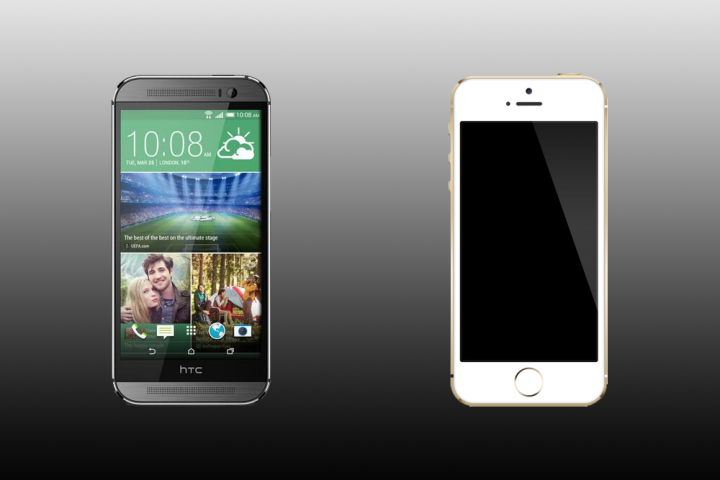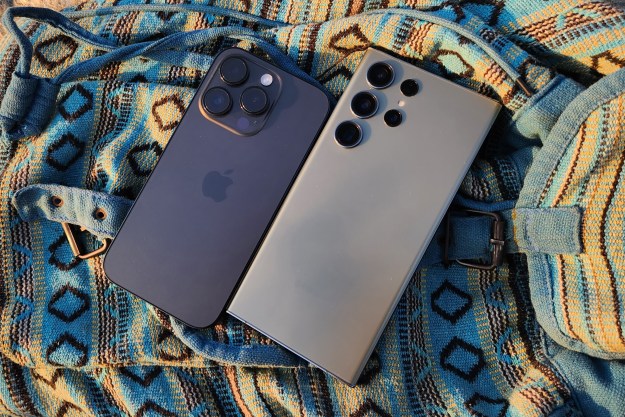
The world of Android smartphones is a competitive one, with companies constantly one-upping one another and leapfrogging into the lead in terms of new technology. Meanwhile, the only manufacturer making an iOS-powered device is Apple. But we can’t quiet the comparisons between the best and brightest of Android against Apple’s flagship phone. HTC updated its popular and well-reviewed HTC One, announcing the HTC One M8. It’s now the talk of Android Town, so it’s only right it gets a crack at Apple’s best. We take a look at the specs of the iPhone 5S and HTC One M8 to see how the two phones stack up.
iPhone 5S |
HTC One (M8) (2014) |
|
| Size | 123.8 x 58.6 x 7.6 (mm) | 146.4 x 70.6 x 9.4 (mm) |
| Weight | 112g | 160g |
| Screen | 4.0-inch LCD | 5.0-inch Super LCD3 |
| Resolution | 1136×640 pixels | 1080×1920 pixels |
| OS | iOS 7 | Android 4.4 with HTC Sense UI |
| Storage | 16/32/64GB | 16/32GB |
| SD Card Slot | No | Yes |
| Processor | 64-bit A7 chip | Quad-core Snapdragon 801 |
| RAM | 1GB | 2GB |
| Connectivity | Wi-Fi, 4G LTE, HSPA+ | Wi-Fi, 4G LTE, HSPA+, NFC |
| Camera | Front 1.2MP, Rear 8MP | Front 2.2MP, Rear 4UP |
| Bluetooth | Yes, version 4.0 | Yes, version 4.0 |
| Motion Processor | M7 chip | N/A |
| Fingerprint sensor | Yes | No |
| Battery | 1570 mAh | 2600mAh |
| Charger | Lightning connector | Micro USB |
| Marketplace | Apple App Store | Google Play Store |
| Ave. Price | $200+ | $200+ |
| Availability | AT&T, Verizon, Sprint, T-Mob | AT&T, Verizon, Sprint, T-Mob |
| DT Review | 4.5 out of 5 | Coming Soon |
Processor and Battery Life
Unsurprisingly, the HTC One M8 gets an update to the hardware that will make it faster than ever. The flagship phone from HTC comes equipped with the latest processor from Qualcomm, the Snapdragon 801. It clocks in at 2.3GHz and is paired with 2GB of RAM on board. This makes the HTC One M8 one of the most powerful phones on the market, and the company wants users to get the most out of the device so they’ve optimized the battery performance. HTC promises 40 percent improvement over the original One and two weeks of standby mode.
Everything in terms of performance and power for the iPhone derives from its A7 chip set. The iPhone 5S is still the only smartphone on the market that can claim 64-bit architecture, which is likely a selling point for those who are looking for some extra power. The iPhone 5S blows away a lot of phones when it comes to performance testing, and an additional motion sensor makes it a solid option for fitness buffs (though HTC claims the One M8 can be used as an activity tracker as well). As for the battery, Apple claims 250 hours of standby (over 10 days) and 10 hours of talk time, which should be plenty for most users.
Operating System and User Interface
We all know the fights that occur between fans of iOS and Android, as if one operating system is clearly better than the other. So there’s sure to be some contention here between these phones. Apple’s iPhone 5S obviously runs iOS, which remains arguably the slickest and most intuitive user interface around. Worked into the UI on the iPhone 5S is addition of the occasionally controversial fingerprint sensor. All in all, you know what you’re getting when you pick up an iPhone and iOS just works.
HTC’s One M8 continues to use the company’s own Sense UI built atop Android 4.4. Sense has now reached version 6, sometimes referred to on stage during the phone’s announcement as Sixth Sense. The new version of the UI retains the Flipboard-style home screen of BlinkFeed, which is now open to developers to push information into the feed (e.g.: Foursquare, FitBit, etc.). Sense also allows users to use the One M8 as TV remote, with social feeds and sports stats added into the remote app. Users will also have a unique way to interact with the HTC One M8, as gestures are enabled even when the screen is off.
Camera
The camera in Apple’s iPhone 5S is definitely functional and capable of taking great shots and clean video but in comparison to what a lot of companies have started to do, it can seem a little plain. There’s not much for add-ons and features or editing suite on board for the iPhone camera, it’s just a good lens that works well.
HTC has gone the way of Samsung when it comes to the camera on the One M8, adding in all kinds of camera modes and gimmicks. There’s facial recognition for your photo galleries, background blurring, various filters, and highlight videos that automatically cuts video to the sound of music you select. There’s a lot of things you can do with the photos and videos after you take them. The One M8 should capture great photos thanks to an updated version of its Ultrapixel lens and a dual-camera system that makes it capable for the back camera to capture depth information on each shot. Some of it may be gimmicky, but the lenses on the HTC One M8 appears to be the real deal.
As is often the case when it comes to comparing phones with different operating systems, the ecosystem is going to be the biggest selling point. If you feel comfortable with one more than another, you’ll want that phone even if some of the specs are worse. Getting your hands on the HTC One M8 and iPhone 5S and trying both out is the best way to determine which phone is best for you. You’ll be able to do that immediately, since both smartphones are out now.
Editors' Recommendations
- 5 phones you should buy instead of the iPhone 15 Pro Max
- 5 phones you should buy instead of the iPhone 15 Pro
- Samsung Galaxy S24 vs. iPhone 15: don’t buy the wrong one
- iPhone 15 Pro Max vs. Samsung Galaxy S23 Ultra: which one is best?
- Want to turn your iPhone into a Galaxy S23? This app is for you


